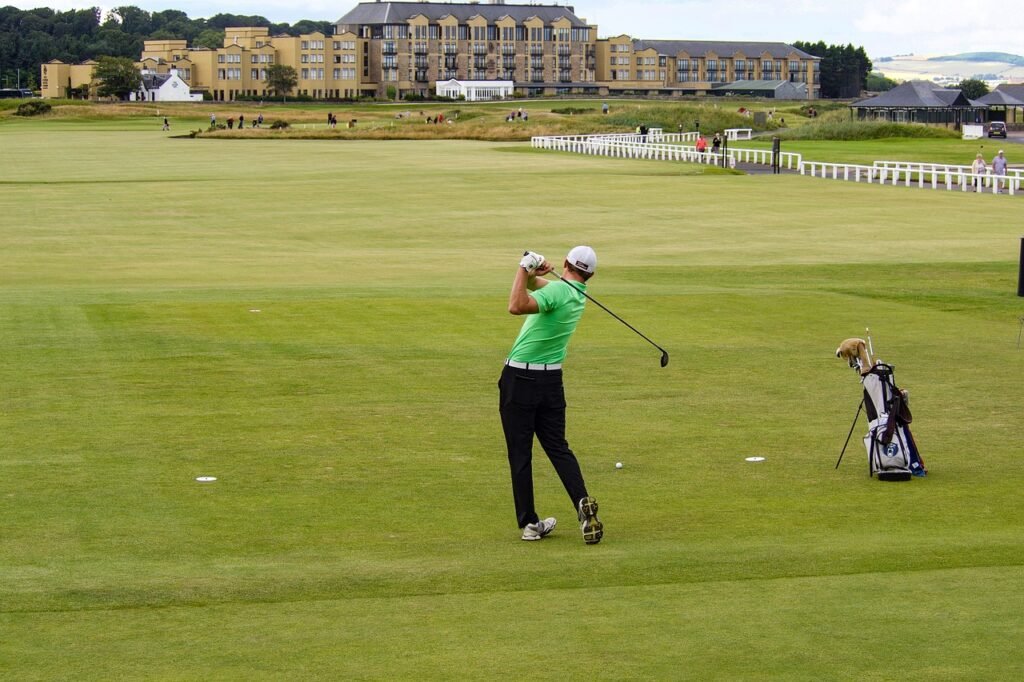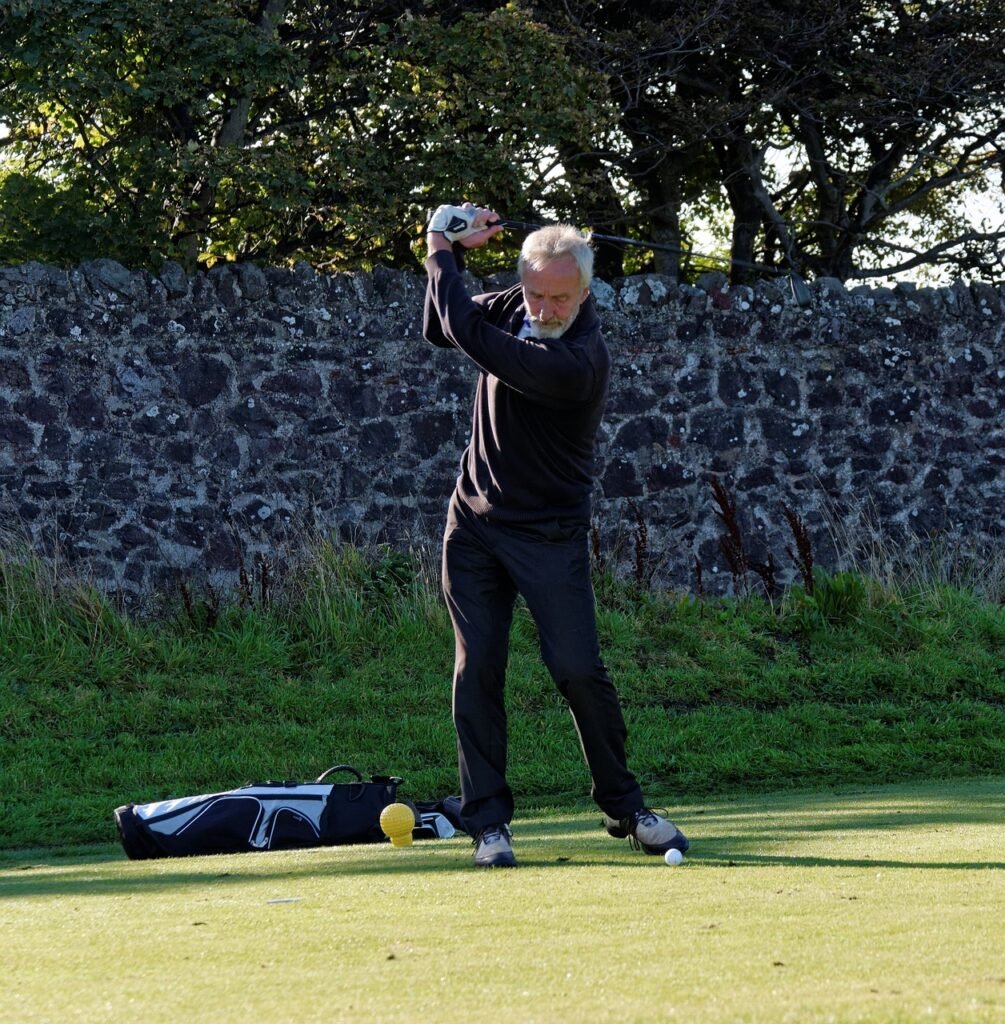Here’s an overview:
- Understanding the One Plane Golf Swing: The Basics
- The History and Development of the One Plane Swing
- Key Principles of the One Plane Swing Technique
- Comparing One Plane and Two Plane Golf Swings
- Essential Equipment for a One Plane Golf Swing
- Mastering the Setup: Address and Stance
- The Mechanics of the One Plane Swing: Backswing to Follow-Through
- Common Mistakes and How to Avoid Them
- Drills and Exercises to Perfect the One Plane Swing
- The Mental Game: Focus and Consistency in Execution
- Fine-Tuning Your Swing: Tips From the Pros
- Integrating the One Plane Swing into Your Game: Transition Strategies
- Case Studies: Success Stories of One Plane Swing Champions
Understanding the One Plane Golf Swing: The Basics
When it comes to swinging a golf club, the one plane golf swing stands out for its simplicity and efficiency. It’s a swing style that maintains a single geometric plane from setup to follow-through. Here’s a breakdown of the essentials to get you started:
- Alignment of the Shoulders and Club: In a one plane swing, your shoulders should be aligned parallel to the target line, and the angle of the club should match the tilt of your shoulders at address. This sets up a ‘single plane’ that the club will move along during the swing.
- Backswing: As you take the club back, your arms and the club should move back in unison, maintaining that single plane. There’s no need for dramatic wrist cocking or vertical arm movement. The goal is to keep your arms extended and the club’s butt end pointing at the target line for as long as possible.
- Downswing and Impact: Initiating the downswing, your hips and core lead as your arms drop into position. The club head follows along the same plane it took going back. At impact, your body should be in a similar alignment to how it started, with your arms and club shaft forming a straight line down to the ball.
- Follow-through and Finish: Continuing with the swing, the club should trace a symmetrical path on the other side of the ball post-impact. Your body’s rotation and the momentum of the swing will naturally bring the club around to finish over your lead shoulder.
Remember:
“Golf is deceptively simple and endlessly complicated.” – Arnold Palmer
This quote highlights that while the basics of the one plane swing may appear straightforward, mastering it takes practice and dedication. Stick to these elementary steps, and you’ll be on your way to a more consistent and effective golf swing.
The History and Development of the One Plane Swing

The one plane swing in golf is a methodology that came to the limelight due to its simplicity and efficiency. It contrasts with the conventional two plane swing by keeping the club on a single plane from takeaway through to follow-through. This approach is favored for its replicability and the consistency it offers golfers.
Historically, the one plane swing has its roots going back to the earliest days of golf. While not formally recognized or taught in the classic eras, natural swingers of the club often used a one plane motion simply out of instinct. It wasn’t until the modern era of instruction and analysis that the technique got its due attention.
Renowned figures in the golf world, such as Ben Hogan, are often cited as early adopters of swings resembling the one plane model. Hogan’s authoritative book, “Five Lessons: The Modern Fundamentals of Golf,” hinted at principles aligning closely with the one plane theory, although he did not expressly categorize his swing as such.
In the 1990s, the one plane swing was popularized by Jim Hardy, a noted golf instructor. He distinguished between one and two plane swings in his teachings, celebrating the former for its ability to generate power through a more horizontal and body-centric movement. Hardy’s protégé, Chris O’Connell, continued to refine and teach the one plane swing to a new generation of golfers.
In the modern-day, a significant turning point for the swing came with the success of golfers like Bryson DeChambeau, whose analytical approach to the sport saw him adopt a one plane swing. DeChambeau’s use of single-length clubs complements this swing technique, further lending credibility and attention to the method.
Over time, the one plane swing has evolved from an unconscious motion of the early golfers to a sophisticated technique optimized through sports science and biomechanics. Golf instructors continue to refine and advocate for this style, providing golfers with tools to master it.
Key Principles of the One Plane Swing Technique
The One Plane Golf Swing is a methodology that simplifies the golf swing by keeping the club on a single plane throughout the swing. This approach is designed to create a more efficient and repeatable swing for golfers of all skill levels. Below are several key principles that underpin the One Plane Swing technique:
- Maintain a single swing plane: The primary goal is to keep the clubhead moving along the same plane during both the backswing and the downswing. This plane should be angled based on the natural tilt of the golfer’s body when addressing the ball.
- Body rotation over lateral movement: Rather than emphasizing lateral shifts of the body, the One Plane Swing focuses on a rotational motion. The golfer’s torso turns around a stable spine, which is the axis of the swing.
- Matching arm and shoulder movement: In a one plane swing, the arms and shoulders should move in unison. The golfer’s lead arm should remain relatively on the same plane as the shoulders throughout the swing.
- Consistent posture: Keeping a consistent spine angle from address to follow-through is crucial. Any unnecessary up-and-down or side-to-side motion is typically avoided to maintain the simplicity of the swing plane.
- Clubface control: In controlling the clubface, the golfer works to keep the face square to the swing plane. This aids in reducing slices or hooks and promotes straighter shots.
- Simplicity and repetition: The overarching benefit of the One Plane Swing is its simplicity. Fewer moving parts mean fewer things that can go wrong, leading to a more repeatable swing that can be executed with consistency.
Each of these principles is crucial for golfers seeking to master the One Plane Swing, as they work together to create a harmonized and fluid movement that can lead to improved accuracy and power.
Comparing One Plane and Two Plane Golf Swings

Understanding the core differences between one plane and two plane golf swings can be a game-changer for any golfer. With the one plane swing, simplicity reigns. Golfers aim to keep the left arm (for a right-handed golfer) on the same geometric plane as the shoulders throughout the swing. This reduces moving parts and often leads to greater consistency.
In contrast, the two plane swing involves a more pronounced shift. The arms and shoulders operate on different planes, with the club being lifted more vertically during the backswing. This method typically allows for greater power but requires more timing and coordination, which can challenge consistency.
Key differences include:
- Posture and Setup: The one plane swing often begins with a more bent-over stance, encouraging the alignment of the arms and shoulders, whereas the two plane swing usually features a more upright posture.
- Backswing: In the one plane swing, the golfer aims to keep the hands and club on the same plane. While in the two plane swing, the hands have a more upward trajectory, separating from the rotation of the shoulders.
- Downswing: The one plane golfer seeks a synchronized return to the ball, with less need for hand manipulation. The two plane swinger, however, typically needs to actively realign the hands and shoulders to return the club to impact position effectively.
- Simplicity vs. Power: One plane swings trade some potential power for ease and consistency. Conversely, a two plane swing can generate more clubhead speed but at the cost of a more complex, timing-reliant motion.
Choosing between the two methods often comes down to a golfer’s natural tendencies, physical capabilities, and personal preferences. While mastering either swing type takes dedication and practice, understanding both can lead to a more informed approach to improving one’s game.
Essential Equipment for a One Plane Golf Swing
When aiming to perfect a one plane golf swing, selecting the right equipment can make a significant difference. Golfers should consider the following essentials:
- Golf Clubs: Look for clubs with flatter lie angles and more flexible shafts. These characteristics help maintain the desired swing plane.
- Drivers and Woods: Some players may benefit from a driver with a slightly shorter shaft, as it naturally encourages a more compact, one plane swing.
- Irons: Ideally, one plane golfers should opt for irons with a wider sole. This design can assist in maintaining a consistent path through the hitting zone.
- Golf Balls: Balls with a low spin rate can be advantageous, as the one plane swing is typically more about control and less about creating backspin.
- Grip Aids: Since grip is a crucial element, consider grip aids or tapes that encourage a stronger vs. weaker grip, which aligns with the philosophies of a one plane swing.
Equip yourself with comfort and performance in mind:
- Golf Gloves: A high-quality golf glove helps prevent slippage and ensures a stable grip throughout the swing.
- Shoes: Stability and balance are key, so look for golf shoes that offer good support and ground connection.
- Training Aids: There are special swing trainers designed to help golfers maintain a one plane swing. Using these periodically can reinforce muscle memory.
- Swing Analyzer: Modern technology like swing analyzers can offer feedback on your swing plane and suggest areas of improvement.
Investing in the right gear assists in engraining the one plane swing patterns and leads to a more consistent game.
Mastering the Setup: Address and Stance

Perfecting your address and stance is crucial when aiming to master the one plane golf swing. Unlike the traditional two-plane swing, the one plane swing aims for simplicity and consistency, which all begin with how you set up to the ball.
At address, your feet, knees, hips, and shoulders should all be in parallel alignment to the target line. This alignment ensures that all parts of your body are working together during the swing, which is essential for the one-plane motion.
For the one plane swing:
- Feet Position: Set your feet shoulder-width apart. This provides a solid and balanced foundation. Your front foot can be turned slightly towards the target, which helps with hip rotation during the swing.
- Knee Flex: Ensure you have a slight bend in your knees. Too much bend can lead to a loss of balance, while too little can restrict your movement.
- Spine Angle: Your spine should be tilted forward from the hips, maintaining a straight back. This tilt is a bit more pronounced in the one plane swing to promote a flatter swing plane.
- Arm Position: Your arms should hang naturally. The distance from the body varies per individual, but it’s typically less than in the two-plane swing, helping to ensure that both arms work as a single unit.
- Grip: Use a grip that feels natural and comfortable, ensuring that both hands work together as one. The V’s formed by the thumb and forefinger of each hand should point towards your right shoulder (for right-handed golfers).
- Clubface Alignment: The clubface should be square to the target line as it’s the basis for straight shots.
Focusing on consistent practice with these setup fundamentals will pave the way for a solid one plane swing. Remember, the objective of this swing style is efficiency, and that starts with a well-executed address and stance.
The Mechanics of the One Plane Swing: Backswing to Follow-Through
Understanding the mechanics of the one plane swing is crucial for mastering it. Unlike the traditional two plane swing, the one plane swing is designed to create a more uniform motion that is easier on the body and provides more consistent results. Here’s how you go about it from backswing to follow-through:
- Setup and Address: Stand with your feet shoulder-width apart, ensuring your spine is tilted slightly away from the target, promoting a flatter swing path. Your club and arms should form a straight line with your shoulders, all lying on the same plane.
- Backswing: Initiate the backswing by rotating your shoulders around the spine, maintaining that single plane line. The goal is to keep the club’s shaft parallel with the line across your shoulders as you reach the top of the backswing. Your arms and shoulders should turn in unison, with minimal wrist hinge, keeping the club’s butt end pointing towards the ball as long as possible.
- Transition: As you reach the peak of your backswing, your weight naturally shifts to the inside edge of the right foot (for right-handed golfers). From this loaded position, you begin the downswing by shifting your weight back to the left side, while your arms drop down, still on the same plane.
- Downswing: Maintain the single plane as you bring the club down, leading with the hips and allowing the hands and arms to follow. The hips clearing the way permits a more direct path to the ball, which results in cleaner, more powerful contact.
- Impact: Keep your wrists firm and continue rotating your body through the ball. Your trailing arm should be straight, mirroring the arm position at setup.
- Follow-Through: Conclude with a balanced finish, with your weight fully shifted onto your leading leg. Your body should face the target, and your belt buckle should point at or just past the target line. The club should finish high and over your lead shoulder, while your spine remains slightly tilted away from the target, replicating that one plane posture.
Breaking down each part of the swing into these components allows golfers to focus on maintaining that single plane from backswing through to the follow-through, resulting in a simplified, repeatable, and effective golf swing.
Common Mistakes and How to Avoid Them
When working on mastering the one plane golf swing, even the most diligent golfers can sometimes hit a rough patch. Here are some common missteps that can throw a wrench in your swing, along with tips on how to steer clear of them.
- Over Rotation in the Backswing: A lot of golfers think more rotation equals more power. Not true. Overdoing it can lead to a loss of control. Keep your backswing compact and focused on loading power efficiently.
- Incorrect Posture: Slouching or being too rigid can ruin your swing. You want a nice, athletic stance. Make sure you’re bending at the hips, not the waist, keeping your back straight.
- Improper Weight Transfer: It’s easy to get this wrong. Your weight should shift to the back foot on the backswing and then to the front foot as you swing through. Some golfers forget to shift back, which is a no-go.
- Releasing the Club Too Early: Hold your fire! Releasing the club too early in the downswing can cost you power and accuracy. Think of the club as a whip, and you’re looking to crack it at the very bottom of your swing.
- Failing to Maintain the Lead Arm: One of the keys to the one plane swing is maintaining a relatively straight lead arm. Don’t let it bend too much; it can mess up your swing plane and the consistency of your hits.
Remember, practice doesn’t make perfect if you’re repeating the same mistakes. Take the time to self-critique or get a pro to eyeball your swing. A tweak here and there can make a world of difference. You’ve got this – one plane at a time!
Drills and Exercises to Perfect the One Plane Swing

Perfecting the one plane swing is about consistency and practice. Here are a variety of drills and exercises to help golfers master this efficient swing path.
- Alignment Stick Drill:
- Place an alignment stick on the ground pointing directly at your target.
- Set up so that the stick is in line with your feet, hips, and shoulders.
- Swing along the path of the stick, ensuring that your clubhead follows this line on both the backswing and follow-through.
- Towel Under Arm Drill:
- Tuck a towel under the arm of your lead shoulder.
- Take swings without letting the towel drop to maintain a connected swing, promoting a one plane motion.
- Headcover Under Arm Exercise:
- Similar to the towel drill, place a headcover under the trailing arm.
- The goal is to keep the headcover from falling throughout the swing to ensure your arms and body move as one unit.
- Half-Swing Practice:
- Focus on making half-swings where the lead arm is parallel to the ground at the top of the backswing.
- This shortened motion helps in learning the proper one plane swing path without over rotation.
- Mirror Work:
- Stand facing a mirror and practice taking the club back, paying close attention to keeping the club shaft parallel to your shoulder line.
- This visual feedback is crucial for understanding the one plane swing.
- Use of Video Analysis:
- Record swings from both face-on and down-the-line views.
- Analyze the footage to check for a consistent plane between the lead arm and the club shaft.
- Golf Swing Trainer Clubs:
- Utilize specially designed training clubs that help ingrain the feeling of the one plane swing.
- These clubs often have curved shafts or weighted heads to reinforce proper swing mechanics.
By incorporating these exercises into a regular practice routine, golfers can develop a reliable one plane swing that delivers repeatability and improved performance on the course.
The Mental Game: Focus and Consistency in Execution
The one plane golf swing, like all technical aspects of golf, requires not just physical skill but a strong mental game as well. Mastering the mental facets is every bit as critical as perfection in the mechanics. As golfers cultivate the finesse of this swing, they realize that the bedrock of consistent execution lies in unwavering focus and mental fortitude.
Focus is the catalyst for precision. It’s all about being present in the moment and engaging with each step of the swing—from setup to follow-through. When golfers keep their mental spotlight on the swing’s components, they can more effectively mold their muscle memory, which in turn, fosters a repeatable and reliable swing.
Consistency is another piece of the mental puzzle. It’s what allows golfers to reproduce that optimal swing under varying conditions and pressures. Those who master the one plane swing know that mental resilience is key. They don’t allow one bad shot to disrupt their rhythm. Instead, they rely on a mental script—a series of personal cues or affirmations—that guide each stroke, ensuring that every swing is as close to their ideal as possible.
Developing this level of focus and consistency is not an overnight affair. It entails persistent practice and a dedication to mental training. Golfers might use techniques such as:
- Visualization, picturing each shot before it happens
- Breathing exercises to maintain calm and control
- Goal setting for each practice session to track progress
- Routine development to create a sense of stability and predictability
These deliberate strategies underscore the mental tenacity needed to execute the one plane golf swing with success and grace. Embracing the mental game is not just about managing the swing—it’s about harnessing the power of the mind to elevate overall play.
Fine-Tuning Your Swing: Tips From the Pros
Developing a consistent one-plane golf swing is all about nailing the fundamentals and making small adjustments. Here’s what some of the pros suggest:
- Maintain Balance Throughout the Swing
- To master a one-plane swing, start by ensuring your weight distribution is even and remains stable. Your center of gravity should stay constant from backswing to follow-through.
- Perfect Your Grip
- A neutral grip where neither hand dominates is key. This helps maintain the clubface angle and reduces the risk of hooks or slices. Experiment with grip pressure to find a comfortable, effective hold.
- Align Your Feet and Shoulders Correctly
- Proper alignment sets the foundation for a good swing. Aim to have your feet, knees, hips, and shoulders parallel to the target line. This alignment promotes a swing path that stays on plane.
- Focus on Rotation Instead of Vertical Movement
- One-plane swingers tend to have a more rotational movement around their spine. Practice rotating your torso while keeping your head still to encourage a consistent swing path.
- Use the Right Equipment
- Make sure your clubs are fitted to your body and swing style. Clubs that are too long or too short can force you into a two-plane swing and disrupt your game.
- Drill Your Plane with Training Aids
- Practice with alignment sticks or a mirror to ensure your swing stays on one plane. Visual feedback is crucial for correcting deviations.
Remember, the key to a refined one-plane golf swing lies in simplicity and repetition. Incremental improvements and consistency in practice will translate to a more effective and reliable swing on the course.
Integrating the One Plane Swing into Your Game: Transition Strategies

Transitioning to the one plane swing from a more conventional two plane swing is not a mere overnight adjustment—it requires patience, persistence, and a solid strategy. Here are some practical steps to ease the transition:
- Begin with a Foundation: Start by ensuring your stance and posture align with one plane principles. Your feet should be shoulder-width apart, and your spine should be tilted forward from the hips, creating a more horizontal swing path.
- Slow Motion Swings: Before hitting the ball, practice your swing in slow motion. Focus on maintaining a single plane from backswing to follow-through without the complication of ball contact.
- Drill with Half Swings: Once you’re comfortable with the slow-motion swings, progress to half swings with a mid-iron. Pay attention to your shoulder plane and arm movement, keeping them in unison.
- Use Video Analysis: Record your swing to visually confirm that you’re adhering to the one plane technique. Visual feedback can be incredibly helpful in correcting and solidifying your form.
- Implement Feedback Tools: Stationary alignment sticks or a mirror can be used to check your swing plane and ensure you’re not reverting to a two-plane swing.
- Gradual Club Transition: Start integrating the one plane swing into your game with shorter clubs and gradually work your way up to the driver as your confidence in the new swing grows.
- Regular Practice: Consistency is key. Dedicate time to practice regularly to make the one plane swing feel natural and automatic.
- Seek Professional Guidance: If possible, work with a coach who understands the one plane swing and can provide personalized feedback and adjustments.
Remember, integrating the one plane swing is not just about hitting better shots—it’s about developing a reliable and repeatable action that stands up under pressure. Be patient and let the transition happen at a comfortable pace. With dedication, the one plane swing will become an integral part of your game, leading to lower scores and more enjoyable rounds.
Case Studies: Success Stories of One Plane Swing Champions
The one plane golf swing has its champions and doubters, but the success stories are hard to ignore. Here are a few case studies that demonstrate its effectiveness:
- Matt Kuchar: With his towering height, many would expect Kuchar to have a more vertical swing. Instead, his adherence to a one-plane technique has not only provided him a reliable swing but also a spot in the top ranks of professional golf. Despite critics focusing on the unconventional look of his flat swing arc, the results speak for themselves, with multiple PGA Tour victories.
- Bryson DeChambeau: An advocate of the single plane swing and a true golf scientist, DeChambeau’s successes are a testament to the swing’s efficacy. With meticulous attention to detail and a belief in biomechanics, his unique approach, which includes single-length clubs, has led him to several professional wins, shaking up the golfing world by challenging traditional techniques.
- Ben Hogan: Often considered the father of the modern one-plane swing, Hogan’s story is legendary. After a near-fatal car accident, he modified his technique, favoring the one-plane swing for more consistent ball striking. His triumphant return to golf and subsequent major championships solidify his place as a one-plane swing success story, providing a timeless example for golfers everywhere.
Each of these golfers demonstrates that the one-plane swing is more than just a technique; it’s a pathway to consistency and success at the highest levels of the game. Whether you’re tall like Kuchar, analytical like DeChambeau, or resilient like Hogan, the one-plane swing can be tailored to help any golfer improve their game.
Exploring the concept of a one-plane golf swing on your blog? While diving into this technique, you might also consider linking to resources that discuss the broader learning curve of golf. For example, understanding how long it takes to learn golf can provide your readers with additional context and help manage their expectations as they try new techniques.
For more insights on the learning process and timelines associated with becoming proficient in golf, check out this detailed article at How Long It Takes to Learn Golf.
